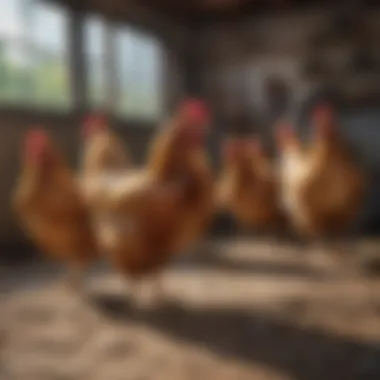Building the Ideal Chicken Coop: A Comprehensive Guide


Intro
Creating a chicken coop requires careful planning and execution. This guide will provide detailed insights on how to build a coop that serves both the chickens and their owners well. It is vital to address safety, comfort, and functionality while considering the needs of your poultry. Here, we will elaborate on suitable materials, design specifics, and practical tips that ensure an efficient and thriving environment.
Key Considerations
In constructing an ideal chicken coop, you should take note of several essential factors:
- Location: Choose a dry and elevated area to prevent flooding and ensure airflow.
- Size: Calculate the appropriate space per chicken. A minimum of 4 square feet per bird is ideal inside the coop and 10 square feet in an outside run.
- Ventilation: Proper airflow avoids moisture build-up, which can lead to respiratory issues in chickens.
By focusing on these key points, the remaining sections will delve deeper into materials, layouts, and other crucial aspects needed for your project.
Materials and Structure
Choosing the right materials is critical in constructing a safe and effective coop. Let's discuss some robust options.
- Wood: Often used for framing and walls, it is durable but must be treated to resist rot and pests.
- Wire Fencing: Essential for runs, choose galvanized steel for a longer lifespan.
- Roofing: A slanted roof helps with rain runoff. Asphalt shingles or metal sheets are good options that also provide insulation.
The structure should provide safety from predators as well as a comfortable environment for the birds. A raised foundation deters predators and also allows for better drainage.
Safety Measures
Ensuring the safety of your chickens is paramount. Here are some measures to consider:
- Secure Locks: Use sturdy locks on doors to prevent entry by raccoons or other animals.
- Inside Nests: Ensure nesting boxes are well-secured and provide privacy for hens.
- Run Area Protection: Cover outside runs with netting to protect against aerial predators.
Regular inspections will also help you spot potential weak points in your structure.
Comfort and Layout
A well-designed layout enhances both functionality and comfort. Arranging the space correctly can reduce stress among the flock:
- Nesting Boxes: Position these in a quiet, low-traffic area to encourage laying. One box per three hens is a good standard.
- Perches: Install perches higher than nesting areas, allowing chickens to roost comfortably at nighttime.
- Feeding and Watering: Allocate space for feeders and waterers but ensure that they are sheltered from the elements.
Maintenance and Care
Post-construction, maintaining the coop is essential for the well-being of your chickens. Regular cleaning prevents disease and keeps living conditions optimal.
- Cleaning Schedule: Implement a weekly cleaning routine. Focus on removing droppings and changing bedding as needed.
- Pest Control: Inspect for mites and lice periodically. Consider natural remedies or safe pesticides if necessary.
A well-maintained coop will not only benefit the chickens but also save time and effort in the long run.
Preamble to Chicken Coops
Chicken coops serve as the cornerstone of poultry husbandry. Understanding their importance goes beyond mere structure; it's about creating a harmonious environment for chickens and their caretakers. An effective chicken coop ensures hygiene, safety from predators, and comfort, all of which contribute to the overall health and productivity of the flock. This article will explore the various aspects of chicken coops, helping readers grasp what makes an ideal setting for their birds.
Purpose of a Chicken Coop
A chicken coop is designed to protect poultry while providing them with a comfortable space to live and thrive. Primarily, coops shield chickens from harsh weather conditions like rain, snow, and extreme heat. Besides protection, coops offer a safe area for hens to lay eggs, a crucial concern for any chicken keeper. By enabling chickens to engage in natural behaviors like roaming and foraging, a well-constructed coop fosters a positive atmosphere.
Another essential purpose is to facilitate feeding and watering. Designed properly, a chicken coop enhances the ease of these daily tasks, which is vital for maintaining flock health. The structure should be arranged to allow for efficient access and cleaning. Additionally, having a designated area for feed storage keeps pests at bay. A good coop becomes a functional space that attends to both care and convenience.
Understanding Chicken Behavior
To build a suitable chicken coop, one must first understand chicken behavior. Chickens are social creatures, and their behavior is guided by a blend of instincts and social structures. They prefer to live in flocks, which means that the coop should accommodate enough space for all chickens. Overcrowding can lead to stress, aggression, or illness.
Chickens display a natural pecking order that dictates their interactions. This hierarchy can affect coop dynamics significantly. Therefore, the coop design should include ample areas for each chicken to retreat to when feeling stressed or challenged by peers.
Another vital behavior to consider is dust bathing. Chickens need space to perform this instinctual activity, which helps them manage parasites and maintain feather health. Hence, plan for a designated dusty area within the coop. Furthermore, it's important to offer roosting bars since chickens naturally seek elevated positions when they sleep. A well-designed coop respects the intrinsic traits of chickens, promoting well-being and contentment.


To ensure a thriving chicken flock, both physical needs and behavioral tendencies must be considered in the coop design.
Key Considerations Before Building
Before embarking on the journey of building a chicken coop, several key considerations must be addressed. These elements are crucial as they can significantly influence both the construction process and the long-term success of poultry management. Understanding each factor cultivates a safe and healthy environment for chickens while also ensuring that owners can efficiently maintain their coops.
Local Regulations and Zoning
Familiarizing oneself with local regulations and zoning laws is among the first steps to take when planning a chicken coop. Many areas have specific requirements regarding the upkeep of chickens, including limitations on the number of birds allowed, coop sizes, and distance from property lines. These rules can vary widely; some urban areas might even prohibit chicken keeping altogether. Ignoring these guidelines can lead to fines or, more concerning, the forced relocation of chickens. It is advisable to check with local government websites or consult with neighbors who may have constructed coops. This initial legwork helps prevent future headaches and assures a lawful approach to poultry husbandry.
Space Requirements for Chickens
Understanding the space needs of chickens is vital for their well-being. Chickens require enough room to roam, roost, and engage in natural behaviors. The general guideline is at least 4 square feet per chicken inside the coop and 10 square feet per chicken in an outdoor run. However, more space is always preferable, as it minimizes stress and aggressive behavior. Moreover, providing ample room contributes to healthier birds and can lead to increased egg production. In addition to square footage, consider vertical space, particularly for roosting areas. Chickens enjoy perching, which can help utilize the upper parts of a coop effectively.
Climate and Environmental Factors
Climate plays a significant role in chicken care and should be carefully considered when planning a coop. Chickens are resilient, but they do thrive within certain temperature ranges. In cold climates, proper insulation is necessary to keep them warm. Conversely, chickens in hot areas need good ventilation to prevent overheating.
- Ensure the coop has adequate airflow, especially during hot months.
- Use materials that provide thermal regulation such as insulated walls.
- Consider positioning the coop in a shaded area or under trees for protection from the sun.
Understand local environmental factors, such as humidity and precipitation patterns, as well. A well-designed coop will take these elements into account, ensuring that chickens remain comfortable throughout the year.
"An informed start lays the foundation for a successful chicken-keeping experience."
By addressing these key considerations, owners can establish a robust framework for their chicken coop project, fostering the health and happiness of their birds while simplifying care management.
Materials for Construction
Selecting the right materials for constructing a chicken coop is vital. The longevity, safety, and comfort of your chickens and the ease of maintenance for their owner all hinge on these choices. Each material has its advantages, and understanding each one's characteristics can help you make informed decisions. Consider whether the materials will withstand weather elements, resist pests, and be easy to clean.
Types of Wood and Their Durability
Wood is often the primary material for chicken coops due to its natural insulation properties and availability. However, not all wood is created equal. Each species has different durability and resistance to the elements. For instance, cedar is known for its natural resistance to rot and insects, making it excellent for outdoor structures. Pine, though more affordable, requires treatment to prevent decay. When choosing wood, consider:
- Cedar: Resistant to rot, lasts long.
- Redwood: Elegant finish, weather-resistant.
- Pine: Economical, requires extra care.
Selecting high-quality wood is essential. Pressure-treated wood can also be an option but ensure it’s safe for animals, as certain chemicals can be harmful. Always look for untreated options, especially for interior surfaces where chickens will nest or roost.
Insulation Options for Coops
Insulation plays a key role in managing the interior climate of a chicken coop. In colder climates, a well-insulated coop helps maintain warmth during freezing temperatures, while good ventilation prevents moisture buildup. Insulation materials might include:
- Foam Board Insulation: Light and easy to install, efficient thermal performance.
- Fiberglass Insulation: Commonly used but must be carefully installed to avoid contact with chickens.
- Straw Bales: A natural, cost-effective option that can provide good insulation.
Consider the local climate when selecting insulation. Proper insulation can lead to healthier chickens by preventing stress caused by extreme weather.
Predator-Proofing Materials
Keeping your chickens safe from predators is one of the most critical aspects of coop design. Various materials can enhance the security of your chicken coop. Metal mesh fencing or hardware cloth provides strengthened protection. Opt for:
- Galvanized Wire Fencing: Durable against rust and corrosion.
- Metal Grating: Adds extra protection at the coop base.
- Solid Metal Doors: Prevents access from opportunistic predators.
It's important to check not only the exterior but also how the coop is constructed internally. Look for gaps where predators could exploit. The goal is to create a fortress for your chickens while fostering a safe environment for them to thrive.
Proper material selection is the foundation of a safe, healthy chicken coop.
By prioritizing materials that balance durability, insulation, and security, you set the stage for both the comfort of your chickens and your success as a poultry owner.
Designing the Chicken Coop


Designing a chicken coop is a central aspect of poultry keeping. The design significantly influences the health, comfort, and productivity of the chickens. A well-thought-out chicken coop can improve functionality for the owner while enhancing the living conditions for the birds. Paying attention to specific elements within the design process will yield long-lasting benefits.
Layout Planning and Functionality
When planning the layout of your chicken coop, consider both the space required for chickens and the ease of accessing various features. Chickens need room to roam, peck, and spread their wings. At least four square feet per bird inside the coop is a common recommendation.
A good layout will also allow for clear movement and operations within the coop. Grouping features like nesting boxes, feeding areas, and roosts logically makes daily tasks easier. For example, place the feeding area near the entrance to simplify refilling food. Ensuring that pathways are clear can prevent accidents and stress among the birds.
Roosting and Nesting Areas
Roosting and nesting areas are vital for the well-being of your chickens. Chickens naturally seek high places to roost at night, as they feel safer this way. Therefore, designing high roosts can accommodate this behavior effectively.
Nesting boxes should be easily accessible but somewhat hidden for privacy. A common rule is to provide one box for every three hens. Boxes should be filled with appropriate bedding material to ensure comfort.
Ventilation and Natural Light
Good ventilation and natural light are essential for any chicken coop. Proper airflow keeps the coop fresh and helps manage humidity. This is important for preventing respiratory issues in chickens. Designing the coop with adjustable vents can help achieve this balance.
Natural light serves multiple purposes. It encourages healthy laying habits and helps regulate the chickens' circadian rhythms. Placing windows or using transparent roofing materials can maximize light exposure. Be sure that these openings can be closed when necessary to control temperature.
Accessibility Features for Owners
Designing a chicken coop with accessibility in mind benefits the owner immensely. Ensure that all areas of the coop can be easily reached for maintenance tasks. This includes feeding, cleaning, and health checks. Consider installing ramp entrances for easy access to the coop.
Incorporating easy-open doors or removable panels can also facilitate maintenance. Properly designed accessibility will decrease the time spent on chores, allowing for more time spent enjoying your chickens.
A well-designed chicken coop not only meets the needs of your birds but also provides ease of management that maximizes your enjoyment of poultry keeping.
Construction Tips and Techniques
Building a chicken coop is not merely an exercise in creativity but rather a critical task that demands careful planning and execution. Proper construction techniques can safeguard the health and well-being of the flock while also reducing the maintenance burden on owners. Understanding the elements of construction is beneficial for achieving a durable and functional coop that meets the diverse needs of chickens and their caretakers.
Foundation and Flooring Options
The foundation of a chicken coop has a fundamental role in its overall stability and longevity. A solid foundation prevents water accumulation, which can lead to damp conditions detrimental to health. Concrete, gravel, or pressure-treated wood can serve as reliable options for foundations. Each material offers unique advantages. For instance, concrete is highly durable and resistant to pests. Gravel promotes excellent drainage, while treated wood provides a natural look at a lower cost.
The flooring inside the coop should prioritize cleanliness and comfort. Options such as wood, vinyl, or concrete all bring different strengths. Solid wood can offer warmth but may require regular cleaning to prevent odor. Vinyl allows for easier cleaning processes, while concrete, although cold, can be sanitized effectively. Opting for elevated flooring can also deter pests and moisture accumulation, ensuring a healthier environment for the chickens.
Framing the Structure
Framing is crucial in providing the structure with strength and resilience. The choice of materials is significant; wood is often favored for its accessibility and ease of use. Pressure-treated lumber, while often used, may involve safety concerns with chemical treatment in a poultry environment. As an alternative, opting for untreated wood with appropriate sealing can still yield a robust frame.
In constructing the frame, ensure that you follow geometric principles. Square and level framing prevents future issues with doors and insulation. It is worth considering using metal fasteners for additional strength. This can effectively enhance structural integrity, which is essential for enduring harsh weather conditions.
Standards for Framing:
- Use quality lumber: Ensure it's free from defects.
- Adequate height: Provide enough vertical space for roosting and movement.
- Ventilation: Incorporate spaces in the frame for windows or vents to enhance airflow.
Roofing Solutions for Chicken Coops
Choosing the right roofing solution is key to shielding the coop from weather impacts. A sturdy roof will protect the chickens from rain, snow, and intense sunlight. Various materials can be utilized: metal roofing is popular due to its long-lasting nature and resistance to elements. Alternatively, shingles offer aesthetic appeal, but they may require more frequent maintenance.
The pitch of the roof also deserves attention. A steeper angle helps in preventing snow accumulation and rainwater pooling, thus minimizing leaks and rot over time. Furthermore, insulating the roof can maintain a stable temperature within the coop, which is essential in extreme weather conditions.
It is important to ensure that the roofing overlaps well, preventing leaks and potential water damage.
Maintenance and Upkeep
Maintenance and upkeep of a chicken coop are critical for the overall health of the flock and the well-being of both the birds and their owners. A clean and well-maintained coop helps prevent diseases and ensures that chickens remain productive as layers or meat producers. Regular inspections and timely repairs can also prolong the life of the structure, making it a sound investment for poultry enthusiasts. Here, we will delve into two essential aspects: cleaning routines and repairs, providing a clear understanding of best practices in coop management.


Cleaning Routines for Health
Establishing effective cleaning routines is paramount in a chicken coop. The accumulation of waste and soiled bedding can lead to health issues for the birds, such as respiratory problems and infections. It is recommended to adopt a cleaning schedule that includes daily, weekly, and monthly tasks.
- Daily Tasks: Collect eggs promptly and remove any droppings or uneaten food. This helps reduce unpleasant odors and discourages pests.
- Weekly Tasks: Change bedding material and clean surfaces with a safe disinfectant. This minimizes the risk of disease transmission among birds.
- Monthly Tasks: Deep clean the coop, which includes scrubbing the walls, roosts, and nesting boxes. Using a pressure washer can be beneficial for thorough cleaning.
Regular cleaning not only promotes health but also enhances the coop environment, making it more pleasant for both chickens and owners.
Implementing a consistent cleaning routine will foster a healthier environment, leading to happier and more productive chickens.
Repairs and Improvements Over Time
Maintaining a chicken coop involves not only routine cleaning but also proactive repairs and improvements. Weather, wear and tear, and pest infestations can all necessitate repairs.
- Inspect Regularly: Regularly assess the condition of the coop, paying close attention to potential issues like rotting wood, leaks, or broken hardware. Early detection of problems can save time and money.
- Pest Control: Repair any holes or gaps where pests might enter. Consider using wire mesh to cover vents and openings. This protects the flock from potential predators and maintains a secure environment.
- Upgrades: As you become more experienced with poultry management, you might discover ways to enhance the coop. Adding features like automatic watering systems, improved ventilation, or upgraded nesting boxes can significantly increase functionality and comfort.
Common Challenges and Solutions
Building a chicken coop presents multiple challenges. Understanding these challenges and their solutions can optimize the coop's design and functionality. Proper preparation can yield significant benefits, ensuring the harmony between chickens and their environment. Failing to resolve common issues can lead to stress for both the chickens and their owners. This section will detail two critical areas: dealing with pests and predators and addressing weather-related issues.
Dealing with Pests and Predators
Pests and predators pose significant threats to the well-being of chickens. Rodents, raccoons, and hawks can easily access a poorly designed coop. The implications of these threats are serious. Pests can introduce diseases to the flock, while predators can lead to injury or death.
Here are some strategies for effective pest and predator management:
- Secure Enclosures: Ensure that the coop is well-built with strong materials. Use hardware cloth instead of chicken wire for better protection against predators.
- Elevated Coop Design: Elevating the coop can discourage certain pests like rats from nesting underneath. It also helps with drainage.
- Regular Inspections: Routinely check for signs of pest activity, such as droppings or nest materials. Early detection can prevent a larger infestation.
- Traps and Deterrents: Consider using traps for intrusive rodents and motion-activated devices to deter larger animals.
Many owners find it effective to consult with local extension services or pest control experts. Custom solutions may be necessary based on specific threats faced in the area.
Consider the coop as not just a structure but a fortress against nature's threats.
Weather-Related Issues
Weather can have a profound impact on both chickens and their coops. Extreme temperatures, heavy rain, and high humidity levels can affect a flock's health and productivity. Additionally, structural elements must withstand greatly varying conditions.
Here are some ways to manage weather-related challenges:
- Adequate Insulation: Ensure the coop is properly insulated for both hot and cold climates. In colder regions, insulation helps maintain warmth.
- Proper Ventilation: Ventilation is key in preventing the buildup of moisture and ammonia. Install adjustable vents that can be opened or closed based on weather conditions.
- Drainage Systems: A well-planned drainage system is crucial to avoid flooding during heavy rains. Sloped flooring can help with this.
- Shading and Heating Solutions: In hot climates, consider installing shaded areas and using fans. Conversely, heat lamps may be required in cold environments to keep chickens warm.
Culmination: Best Practices for Chicken Coop Success
Building a chicken coop is not merely about providing shelter for your birds; it’s about creating a thriving environment that promotes their well-being and your efficiency as an owner. The best practices summarized here serve to underline the essential elements of an effective chicken coop. These include design considerations, the choice of materials, and regular maintenance routines.
By prioritizing comfort for the chickens and accessibility for yourself, you can minimize stress and enhance productivity. A well-designed coop not only safeguards your chickens from predators but also fosters their natural behaviors, helping them live happier lives. Moreover, a focus on quality construction ensures longevity, making your initial investment worthwhile.
"A proactive approach to coop design and management translates into healthier chickens, which in turn leads to better egg production."
Final Thoughts on Coop Design
The design of a chicken coop significantly impacts the overall health and productivity of your flock. Key aspects include size, ventilation, and safe access to nesting areas. Ensuring ample space is crucial; overcrowding can lead to stress and unwanted behavioral issues. The coop should have proper ventilation to prevent the buildup of ammonia and moisture. These factors also reduce the risk of respiratory issues.
Whaht to keep in mind for coop design:
- Size: Allow around 4 square feet per chicken inside the coop.
- Ventilation: Implement windows or vents that can be closed during inclement weather.
- Nesting Areas: Ensure easy access for egg collection but safe from predators.
Incorporating these features helps to create a balanced ecosystem where chickens feel secure and comfortable. Your attention to detail in the design phase lays the groundwork for successful poultry husbandry.
Future Considerations for Chicken Care
As you progress in chicken keeping, it is wise to continually assess the dynamics of your flock and the performance of your coop. Changes in flock size, breed preferences, and even customer demands may necessitate adaptations in your setup. Keeping informed on best practices in poultry care will be beneficial.
Key areas to focus on include:
- Health Management: Regular check-ups can prevent diseases before they spread.
- Feeding Practices: Adjust diet based on age and laying cycles to optimize egg production.
- Housing Adaptations: Consider seasonal adjustments, such as insulation for winter or shading for summer.
Staying proactive in these areas ensures not just the survival of your flock but their flourishing. Emphasizing ongoing care and adaptation illustrates your commitment to sustainable poultry management.







